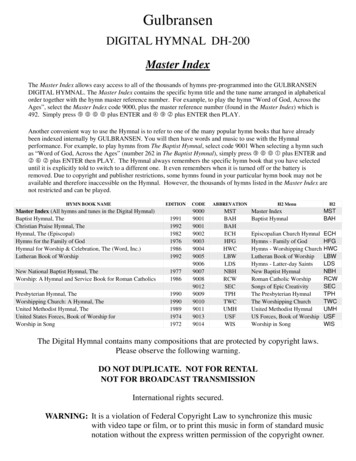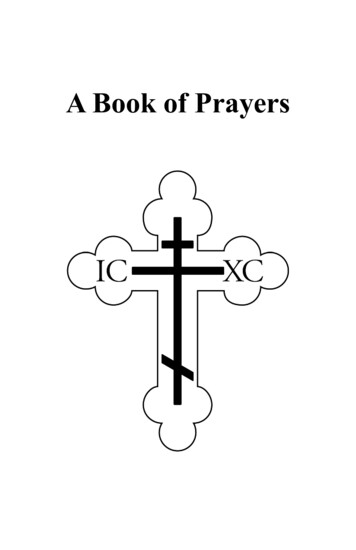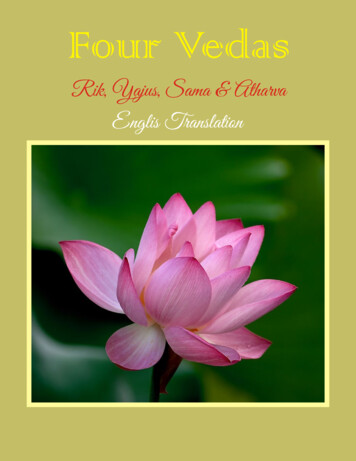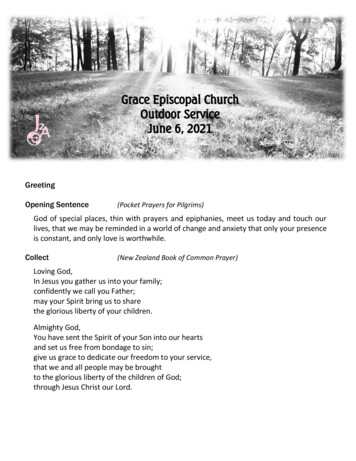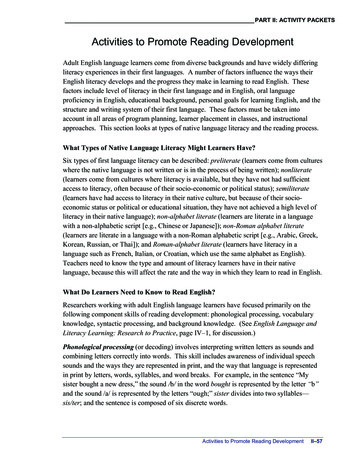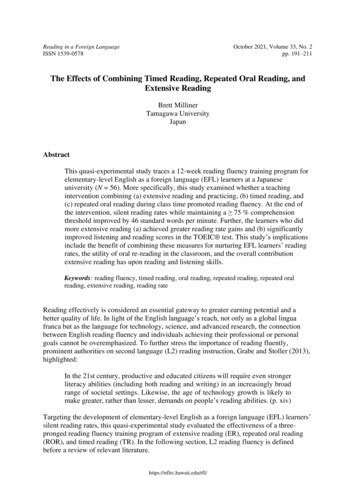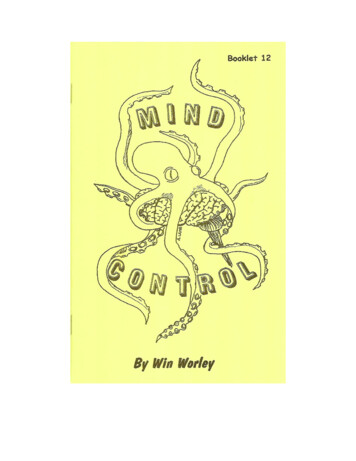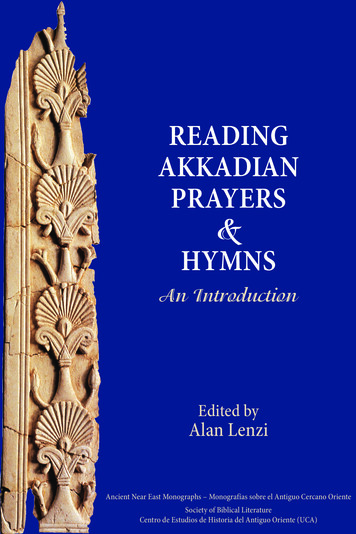
Transcription
ReadingAkkadianPrayers&HymnsAn IntroductionEdited byAlan LenziAncient Near East Monographs – Monografías sobre el Antiguo Cercano OrienteSociety of Biblical LiteratureCentro de Estudios de Historia del Antiguo Oriente (UCA)
Akkadian Prayers and Hymns
Ancient Near East MonographsGeneral EditorsEhud Ben ZviRoxana FlamminiEditorial BoardMichael H. FloydJose GalanErhard S. GerstenbergerSteven W. HollowayAlan LenziMartti NissinenSantiago Rostom MadernaGraciela Gestoso SingerJuan Manuel TebesNumber 3Akkadian Prayers and HymnsA Reader
Akkadian Prayers and HymnsA ReaderEdited byAlan LenziSociety of Biblical LiteratureAtlanta
Copyright 2011 by the Society of Biblical LiteratureAll rights reserved. No part of this work may be reproduced or published in print formexcept with permission from the publisher. Individuals are free to copy, distribute, andtransmit the work in whole or in part by electronic means or by means of any information or retrieval system under the following conditions: (1) they must include with thework notice of ownership of the copyright by the Society of Biblical Literature; (2) theymay not use the work for commercial purposes; and (3) they may not alter, transform,or build upon the work. Requests for permission should be addressed in writing to theRights and Permissions Office, Society of Biblical Literature, 825 Houston Mill Road,Atlanta, GA 30329, USA.The original publication was modified to create this corrected edition on 28 August 2015.Library of Congress Cataloging-in-Publication DataAkkadian prayers and hymns : a reader / edited by Alan Lenzi.p. cm. — (Society of Biblical Literature ancient Near East monographs ; v. 3)English and Akkadian.Includes bibliographical references and index.ISBN 978-1-58983-595-5 (paper binding : alk. paper) — ISBN 978-1-58983-596-2 (electronicformat)1. Assyro-Babylonian religion — Prayers and devotions. 2. Hymns, Akkadian. 3. Akkadianlanguage — Readers. I. Lenzi, Alan.BL1620.A33 2011299’.2—dc232011024929
Table of ContentsAcknowledgments.viiAbout This Book.ixAbbreviations.xixINTRODUCTION.1Prayers and Hymns from a Religious Studies Perspective.2Prayers and Hymns in a General Mesopotamian Perspective.8An Introduction to Particular Classes of Mesopotamian Prayer .23Incantation-Prayers. �ungas. 43Ikribus.46Tamitus and Other Queries. 49Letter-Prayers (“Gottesbriefe”).53Royal Prayers .55Hymns.56The Use of Akkadian Prayers in the Study of the Hebrew Bible .61OLD BABYLONIAN TEXTS.69Prayers of the DivinerAn OB Prayer To the Gods of the Night .71An OB Ikribu-Like Prayer to Shamash and Adad .85OthersAn OB Letter-Prayer to Ninmug.105An OB Royal Hymn to Ishtar .111STANDARD BABYLONIAN TEXTS.131Incantation-PrayersGhosts of My Family 1 .133Girra 2.145Gods of the Night 1 .157Ishtar 24 .169Nusku 12 .179Salt.189Shamash 73.197v
𒁹𒌋𒌋𒁹𒁹Anu 1 .217Ea 1a .227Gula 1a .243Ishtar 2: “The Great Ishtar Prayer”.257Marduk 4 .291Marduk 2 .313Nabu 1 .325Nergal 2.339Nisaba 1.351Shamash 1.367Sin 1 .385Namburbis𒌋𒌋𒁹𒁹𒁹 Ea, Shamash, and Asalluḫi 1 .403𒌋𒌋𒐼 Shamash 25.421Dingirshadibbas𒌋𒌋𒐊 To Personal Deities .431Others𒌋𒌋𒐋 An Ershaḫunga to Any God.447𒌋𒌋𒐌 A Tamitu to Shamash and Adad .465𒌋𒌋𒐍 A NB Royal Prayer to Nabu .475𒌋𒌋𒑆 A Hymn to Marduk: Ludlul bēl nēmeqi I 1–40 .483Contributors.503Index.505vi
AcknowledgmentsSeveral people deserve a word of thanks for their role in the production ofthis book. I first and foremost want to thank all of the contributors for signingon to this project and working hard to bring it to completion. Among the contributors, I especially wish to thank Christopher Frechette, Duane Smith, andAnna Zernecke. Christopher was a constant source of information, conversation,and encouragement. This book has greatly benefited from his sage advice andscholarly knowledge. Duane lent his programming expertise to the project, making the transformation of Unicode to cuneiform as painless as one could hope.He saved me many, many hours of tedious work. Anna graciously took on thereview of biblical scholarship for the general introduction rather late in the project, allowing me extra time to focus on editorial tasks. That section is no doubtthe better for her having written it. I also wish to extend my heartfelt appreciation to several people, including some of the above, who read drafts of my contributions to this volume and offered their suggestions and critical feedback:Tzvi Abusch, Jeffrey Cooley, Christopher Frechette, Eugene McGarry, Seth Sanders, Duane Smith, and Niek Veldhuis. When I did not follow their suggestions, Idid so only after much deliberation, in full knowledge that I alone must takeresponsibility for my work. Monica Schutzman and the Interlibrary Loan staff atUniversity of the Pacific were a tremendous support throughout the duration ofthis project. Getting obscure Assyriological works into the Central Valley is theirspeciality. Leigh Andersen from the Society of Biblical Literature editorial staffwas a patient guide as I laid out the complicated pages of this volume. And finally, I wish to thank my family for allowing me to work ridiculous hours every dayof the week during the final months of this project. They are always a source ofcomfort, joy, and diversion.Alan LenziStockton, CAMarch 18, 2011vii
About This BookALAN LENZIThis book is a pedagogical tool intended to increase reading fluency for second or third semester Akkadian students by way of annotated readings. It isequally an introduction to Akkadian prayers and hymns from ancient Mesopotamia: selected classes, their vocabulary and phraseology, and to some extenttheir ritual uses. Finally, the introductory material in this book exposes readersto theoretical and critical perspectives that will be useful in the study of otherancient religious texts. More advanced students of Akkadian may therefore findsomething profitable here as well.The idea for this book was inspired by tools developed in Biblical and Classical Studies in which lexical and grammatical help is printed on the same pageas the ancient text to be read.1 This arrangement cuts out the time-consumingprocess of looking up words and allows the intermediate student to cement theirbasic grammatical knowledge and expand their vocabulary through extensivereading. There is currently nothing like this available for Akkadian.As many students will attest, academic books are often quite expensive, taking important tools out of the reach of economically-challenged students and/orthose who may be without access to a well-stocked academic research library. Itis gratifying therefore to make this volume available free of charge through theSBL’s electronic open-access Ancient Near East Monograph series. If the readerfinds this tool useful, please feel free to share it with others.Because prayers and hymns—but especially prayers—display stereotypedforms and utilize a manageable core of vocabulary, selecting texts from thisbody of material seemed a perfect choice for this kind of book. But selectingprayers and hymns also serves educational interests beyond Akkadian fluencyfor the book’s targeted audiences. For Assyriological students, learning the formsand vocabulary of prayers and hymns as well as something about the addressees1See, e.g., Peter Jones, Reading Ovid: Stories from the Metamorphoses (Cambridge: CambridgeUniversity Press, 2007); Ehud Ben Zvi, Maxine Hancock, and Richard A. Beinert, Readings inBiblical Hebrew: An Intermediate Textbook (New Haven: Yale University Press, 1993); and RichardJ. Goodrich and David Diewert, A Summer Greek Reader: A Workbook for Maintaining Your BiblicalGreek (Grand Rapids: Zondervan, 2001).ix
xREADING AKKADIAN PRAYERS AND HYMNS: AN INTRODUCTIONof such is an important step toward gaining a broad familiarity with the Akkadian religious textual corpus. The contents and format of this book will facilitateacquiring that familiarity with relative ease, preparing them for advanced study.Although Classicists are increasingly taking an interest in Akkadian, the majorityof non-Assyriological students who study Akkadian comes from the ranks of biblical scholarship. As there is a long history of interaction between Assyriologyand Biblical Studies in the matter of prayers and hymns, selecting texts from thiscorpus again seemed to serve an important segment of Akkadian students. It ishoped that this volume will fill a gap in the available resources to these Akkadian students and spur other scholars on to produce similar pedagogical materialsfor different genres, especially historical inscriptions.THE SELECTION OF TEXTS IN THIS VOLUME:There are a great many texts one might choose to include in a volume ofAkkadian prayers and hymns. We have made our very limited selection according to a few guiding principles.1.Texts included in this volume represent several different kinds of Akkadian prayers. Not every category of prayer is represented, but a good variety is offered. Due to the great number of extant shuilla- and incantation-prayers aswell as their importance in both Assyriological research and the comparative work of biblical scholars, we have included a very generous selectionfrom these categories. As hymns are not nearly as numerous and those preserved are often quite long (e.g., two hundred lines), only a couple of samples have been included. But as one will see, most prayers contain a hymnicelement. So even when reading a prayer, one frequently will gain some exposure to the language of praise as well.2.Texts included in this volume reflect a wide variety of addressees. We have included prayers to most of the high gods of the Mesopotamian pantheon (Enlil, Ashur, and Ninurta are obvious omissions) as well as examples of prayers to personal gods, familial ghosts, and materials used in the cult. Somedeities are very richly represented among extant prayers (e.g., Shamash, Ishtar, and Marduk). We have reflected this popularity by including severalprayers addressed to these gods.3.Texts included in this volume have a suitable modern edition available. Thetreatments offered in this volume do not produce a new critical edition ofthe prayer or hymn under study. That epigraphic and text critical work hasbeen done, freeing contributors to focus on helping students understand thegrammar and meaning of the texts. Satisfying the first two criteria above,however, took precedence over this criterion. There are a few cases therefore in which contributors were forced to use a dated edition (e.g., from Erich Ebeling’s Die akkadische Gebetsserie “Handerhebung.” Von neuem gesam-
ABOUT THIS BOOKximelt und herausgegeben (Berlin: Akademie-Verlag, 1953; abbreviated, Ebeling, AGH).24.Texts included in this volume have accessible modern translations available. Although each treatment includes a fresh translation, choosing to treat previously translated texts ensured that each text would be relatively wellunderstood. This gave contributors conversation partners in their annotations and offers students more resources for in-depth study.5.Texts included in this volume are written in either the Old Babylonian (OB) orStandard Babylonian (SB) dialects of the Akkadian language. Prayers andhymns are preserved in various Akkadian dialects. But most students beginlearning Akkadian with the OB dialect and then progress to SB. It seemedpedagogically appropriate therefore to include prayers in these two dialects(as opposed to also including some in Assyrian or peripheral dialects). Asthe greatest number of prayers and hymns are preserved in SB and mostsecond year Akkadian students will be ready to read these, the SB prayerscomprise the majority of texts treated in this volume.THE CONTENTS OF EACH TEXTUAL TREATMENT:Each textual treatment in this volume is self-contained. A student can beginreading with text no. 13 (𒌋𒁹𒁹𒁹), for example, and have all the information necessary within the treatment to read and understand that text.3 This feature allowsstudents to read the prayers in any order; it also gives professors the flexibilityto assign any sub-set of prayers in the volume without concern that the studentwill be missing something assumed from an earlier textual treatment. Althoughthis manner of presentation results in significant overlap and repetition, this ispedagogically beneficial. Seeing the meanings of the same word over and overwill help a student lock it into their memory. As the student’s reading fluencyincreases, they can easily pass over glosses and annotations that are no longernecessary to them. Each treatment includes the following sections:An introduction to the deity/entity addressed or praisedAn introduction to the prayerThe text of the prayer or hymn in transliterationNotes on the text, including a normalizationComparative suggestionsA translation in EnglishThe text of the prayer in a cuneiform font2One of the most pressing desiderata in Assyriological research related to prayers is a comprehensive edition of all of the known Akkadian shuillas.Cross-referencing between treatments is limited, generally reserved for major issues or reference to deities.3
xiiREADING AKKADIAN PRAYERS AND HYMNS: AN INTRODUCTIONDeity. Each treatment begins with a succinct introduction to the entity addressed or praised in the text. In most cases, this means an introduction to adeity. But in a few treatments, the addressee is undetermined (see the Prayer toAny God on page 447) or not a deity (as in the prayers to familial ghosts, seepage 133, and salt, page 189). These introductions attempt to give somethingmore than what one finds in Jeremy Black’s and Anthony Green’s useful book,Gods, Demons and Symbols of Ancient Mesopotamia,4 but less than the very richand technical entries in the Reallexikon der Assyriologie (RlA). Although the content of the introductions varies, the ones concerned with deities usually includea discussion of the deity’s sphere of power, their position in the pantheon, theiroriginal city, the locations of their major temples, their relationships to otherdeities, their iconographic and astrological representations, and their divinenumber. The purpose of this section is to help the reader gain some familiaritywith the deity so as to understand the broader context of the prayer. The readerwho works through this book will have substantially enriched their knowledgeof a variety of non-obvious beings from ancient Mesopotamia.The Prayer. The second section of each treatment gives an introduction tothe prayer or hymn under consideration. In the case of many SB prayers, thesetexts are identified by the name of the deity invoked followed by a number (e.g.,Shamash 1 or Nusku 12). This identification convention follows Werner Mayer’scatalog of incantation-prayers in his important work Untersuchungen zur Formensprache der babylonischen „Gebetsbeschwörungen“ (abbreviated, Mayer, UFBG).5Although one might expect these introductions to vary due to each text’s individual character, genre, or availability of data, they also vary due to the different interests of the contributing authors. Some contributors give more attentionto the ritual uses of the particular text under discussion while others prefer toexposit the text’s literary features and themes. This diversity of approach willbenefit the reader by illustrating the diverse results various analytical and interpretive methods can produce. The one common denominator in all of the treatments is the identification of the structure of the prayer, that is, how it “works”rhetorically.Essential Bibliography. After the two introductions, each treatment includes an essential bibliography for both the deity and the text treated. The fullcitation for works cited by author or by author and short title in the footnotes tothe introductions will be found here. In the case of prayers and hymns, the bibliography includes references to the most recent edition, several translations,and an important work or two that has discussed the text at some length—ifavailable. As the title of the section indicates, this is only essential bibliographyas judged by the contributors and the editor. It is not exhaustive.4An Illustrated Dictionary (illustrations by Tessa Richards; Austin: University of Texas Press,1992); henceforth, Black and Green.Werner Mayer, Untersuchungen zur Formensprache der babylonischen „Gebetsbeschwörungen“ (Studia Pohl: Series Maior 5; Rome: Pontifical Biblical Institute, 1976), 375–437.5
ABOUT THIS BOOKxiiiEdition: Knowing the edition upon which the treatment’s text is based wasconsidered essential. Full publication information for each witness to or manuscript (MS) of the text was not deemed essential. Usually, one can consult thetext’s most recent edition to learn the identity of the various manuscripts (MSS,that is, tablets) that attest the text. And this will tell the reader where the tabletsare housed and assist them in locating the pertinent hand copies or photos forfurther study. Generally, only in cases where the edition is very dated (e.g.,when the only edition is in Ebeling’s AGH) or is in press (e.g., the shuilla toNisaba) has information about the tablets and/or their copies been included inthe bibliography or its footnotes. Consulting tablets (deciphering or collatingactual tablets and reading from photos or hand copies of tablets) is a very important part of Assyriological research and therefore an essential element of Assyriological training. The present volume, however, is not intended to be ahandbook on cuneiform epigraphy or a manual on how to produce a criticaledition. It is a tool to facilitate more fluent reading in Akkadian religious texts.For readers who want to learn more about the textual basis for an individualprayer, the best place to start is the most recently published critical edition.Translations: References to the translations by Foster (English), Seux(French), and Falkenstein/von Soden (German), when available, are includedamong the essential bibliography, although contributors may choose to add others. Reference to these translators is made by way of their last name alone. Foster’s translations may be found in Benjamin R. Foster, Before the Muses: An Anthology of Akkadian Literature (3d ed.; Bethesda: CDL Press, 2005); Seux’s are inMarie-Joseph Seux, Hymnes et Prieres aux Dieux de Babylonie et d’Assyrie (Paris:Les Éditions de Cerf, 1976); and von Soden’s (in one of our prayers, Falkenstein’s) are in Adam Falkenstein and Wolfram von Soden, Sumerische und akkadische Hymnen und Gebete (Die Bibliothek der Alten Welt; Stuttgart: ArtemisVerlag Zürich, 1953), 233–407. For students interested in digging deeper intothe text of a prayer or hymn, these translations, especially Foster and Seux, are atreasure trove of useful information, often offering different understandings ofthe text, pointing to further bibliography, and sometimes including new witnesses discovered since the production of the text’s critical edition.The Text in Transliteration. Anyone wishing to utilize Akkadian in theirresearch will encounter the language in transliteration, that is, in a sign for signsystem of notation using Latin letters and various diacritical marks. The centerpiece of each treatment therefore is the text of the prayer or the hymn in transliteration. The text is printed a few lines at a time at the top of the page.The text utilized in each treatment generally follows the reconstruction ofthe most recent critical edition with one major exception: in order to avoid overloading the student’s eye with epigraphic technicalities, half-brackets in the editions were ignored. Moreover, no textual apparatus is included and there has beenno attempt to provide in the notes a comprehensive discussion of all of the variants in all of the MSS of each prayer or hymn. Such would have transformed thiswork into something quite different. Occasionally, a departure from the criticaledition’s reconstructed text is identified in a note at the foot of the page. Depar-
xivREADING AKKADIAN PRAYERS AND HYMNS: AN INTRODUCTIONtures may be something as simple as selecting a variant reading rather than theone preferred by the critical edition because the variant provided a pedagogically advantageous text. For example, the edition may have selected the harderreading (lectio difficilior) when deciding between variants whereas the contributor to this volume preferred the one best suited to a pedagogical context. In other cases, the critical edition required the contributors to make a decision aboutwhich lines to include and which lines to exclude. For example, various MSS of aprayer may preserve a self-introduction formula at different places in the prayeror one MS may insert an attalû-formula while others lack it. If the critical editiondid not reconstruct an “original” text (as, e.g., in the editions for Sin 1 and theUniversal Namburbi), the contributors had to make decisions about what wouldbe used in their treatment and what would be excluded. It must be emphasizedtherefore that the texts used in this edition are no substitute for the consultation andcareful study of a modern critical edition and the individual witnesses that preservethe text. For readers who want to understand the textual diversity of a givenprayer or take their study of its text to an advanced level, they absolutely mustconsult the text’s modern critical edition.A word should also be said here about the use of sequential line numberingin the presentation of the texts. Critical editions may reconstruct line numbersbased on what the editor has chosen as the primary textual witness (usuallydubbed MS A). This, for example, was the procedure used by Werner Mayer inthe selection of prayers he edited at the back of UFBG (439–541). In other cases,the editor contrives a system of line numbering that makes the best sense of thepreserved, perhaps fragmentary witnesses and allows for designating what theeditor deems secondary. When variant lines occur, they are given number-letterdesignations (e.g., 7a and 7b would occur after line 7 of the main text) or simplyplaced in a footnote. The potential for confusion in this diversity of methods intext editions is compounded by the fact that some texts are part of a larger, multi-tablet work. For example, the prayers to salt and to Girra included in this volume come from the eight-tablet, anti-witchcraft series called Maqlû, “burning,”and the hymn to Marduk comes from the four-tablet poem Ludlul bēl nēmeqi. Thetexts of these prayers are properly referenced by the tablet in which the textoccurs and then the line number on that tablet (e.g., I 1–40, which means TabletI, lines 1 through 40).For pedagogical purposes, a simplified consistent numbering method wasdecided upon. Throughout the volume, each treatment begins with line number1 and proceeds sequentially to the text’s end, even when the critical edition orthe position of the text in a multi-tablet series indicated otherwise. There is onlyone exception to this practice. In the Universal Namburbi, there is a gap (due toa tablet break) of undetermined length in the middle of the text (see page 412).When the text resumes, the line numbering in this treatment begins with 1ʹ. Asis standard in Assyriological literature, the prime marker (ʹ) indicates that theabsolute line numbering cannot be determined due to a lack of evidence amongthe witnesses (because of a break on a tablet).
ABOUT THIS BOOKxvAnnotations. At the foot of the page are brief notes on each line of Akkadian text. Every logogram in the text is given its Akkadian equivalent and the firstoccurrence of each word in the prayer or hymn is defined briefly.6 At the discretion of the contributor, grammatical and syntactical help is provided for difficultforms or complex sentences. In many notes, the contributor also offers briefcommentary that may highlight a literary feature, a ritual gesture, and/or abroader textual, linguistic, or cultural item suggested by the text. At the end ofeach note the text of the Akkadian line is given again in normalized Akkadian,that is, in a Latin-character transcription that approximates how the languagewould have sounded in ancient times. This normalization is intended to helpclarify the grammar of the line.Assyriologists have differing ideas about how to normalize an Akkadian sentence. Even the dictionaries disagree sometimes about the normalization of individual words (e.g., they often disagree about vowel length and doubled consonants). For consistency’s sake, contributors were asked to follow JohnHuehnergard’s system of normalization as practiced in his popular pedagogicalgrammar, A Grammar of Akkadian, 2d ed.,7 and the normalization of words according to the handbook dictionary most students will use in their early studies:A Concise Dictionary of Akkadian (CDA,8 based on von Soden’s AHw9). But thereis an important caveat with regard to the latter’s use. Unlike the CDA, whichalways gives the lemma in OB form, the glossed words and normalized lines oftext in this volume always use OB forms in OB texts and SB forms in SB texts(e.g., amātu instead of awātum in SB texts). An alternate normalization or the OBform is sometimes given alongside an Akkadian word that is glossed in thenotes. The alternates are given in order to facilitate looking these words up inthe Chicago Assyrian Dictionary
this book. I first and foremost want to thank all of the contributors for signing on to this project and working hard to bring it to completion. Among the con-tributors, I especially wish to thank Christopher Frechette, Duane Smith, and Anna Zernecke. Christopher was a constan
